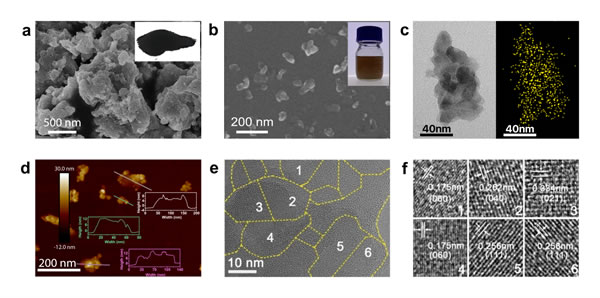Shenzhen Advanced Institute invented chemical etching method to prepare polycrystalline black phosphorus nitrogen fixing catalyst
Recently, the team of Yu Xuefeng of Shenzhen Institute of Advanced Technology, Chinese Academy of Sciences has made new progress in the field of two-dimensional black phosphorus, and developed polycrystalline black phosphorus nanosheets with multi-boundary characteristics, showing good performance in the photocatalytic synthesis of ammonia. The related work "Edge-Rich Black Phosphorus for Photocatalytic Nitrogen Fixation" was published in the international journal The Journal of Physical Chemistry Letters (J. Phys. Chem. Lett. 2020, 11 , 1052). The co-first author of the paper is Dr. Bian Shi and Wen Min from Shenzhen Advanced Institute, and the corresponding author is researcher Yu Xuefeng.
Ammonia (NH3) is not only one of the most important components of the earth's nitrogen cycle, but also an indispensable chemical in modern society. Seeking an efficient, low-consumption, clean nitrogen-fixing ammonia synthesis method to replace the energy-intensive Huber method has been a research hotspot in recent years. Due to the low cost of solar energy, photocatalytic ammonia synthesis technology that converts solar energy into product chemical energy is an ideal way, and the material basis for achieving efficient photocatalytic nitrogen fixation is semiconductor photocatalysts. Black phosphorus is a new type of non-metallic layered direct bandgap semiconductor material with unique properties such as high carrier mobility and adjustable bandgap covering visible to mid-infrared. In the previous work, Yu Xuefeng's research group conducted in-depth research on the application of black phosphorus catalysis and chemical synthesis, such as the development of black phosphorus platinum catalyst (Adv. Mater. 2018, 1803641. Angew. Chem. Int. Ed. 2019, 58, 19060.), black phosphorus directly synthesize organic phosphide (CCS Chem. 2019, 1, 166), etc.
In this study, the research group innovatively established ball milling chemical etching technology and successfully converted the red phosphorus powder directly into a new type of black phosphorus nanosheets with polycrystalline boundary characteristics (Figure 1). Traditional black phosphorus nanosheet materials usually have a single crystal-like structure with smooth surfaces and sharp edges; in contrast, this new type of black phosphorus nanosheets exhibits polycrystalline structural characteristics. Defect sites formed by independent crystal domain boundaries, so the surface is rugged and the edges are smooth. Such sites on the surface have an obvious adsorption function for nitrogen molecules, so it has a positive effect on the performance of catalytic nitrogen fixation. The follow-up experiment of the research group applied this new type of black phosphorus nanosheets as a catalyst to aqueous phase photocatalytic nitrogen fixation, and related studies have shown that it has excellent photocatalytic nitrogen fixation activity in aqueous systems (Figure 2). With the help of an appropriate amount of electron sacrificial agent, the entire system can achieve a stable photocatalytic nitrogen fixation reaction under visible light irradiation; and it can maintain performance without decay under 8 hours of continuous light, and its average activity also exceeds most reported Catalytic system.
The research team further studied the mechanism of the polycrystalline black phosphorus catalyst system (see Figure 3). In the PEC test, the response of the polycrystalline black phosphorus nanosheets in a nitrogen atmosphere was significantly stronger than that in an argon atmosphere; In the TA test, the signal decay time of polycrystalline black phosphorus nanosheets in a nitrogen atmosphere is also significantly shorter than that in an argon atmosphere. Both experimental results confirmed the process of nitrogen taking photogenerated electrons from the surface of polycrystalline black phosphorus. In addition, compared with the traditional crystal growth & liquid phase stripping method, the ball milling & chemical etching method developed in this study greatly reduces the cost and time of preparing black phosphorous nanomaterials. This low-cost and efficient method shows black Phosphorus nanomaterials have great potential for industrial production in the future.
The project was supported by the National Natural Science Foundation of China, the Chinese Postdoctoral Science Foundation, the Chinese Academy of Sciences Key Frontier Science Research Program, the Guangdong Leading Talent Program, and the Shenzhen Basic Research Layout.

Fig.1 Morphology and structure characterization of polycrystalline black phosphorus nanosheets

Figure 2 Characterization of photocatalytic nitrogen fixation performance of polycrystalline black phosphorus nanosheets

Figure 3 Study on the mechanism of photocatalytic nitrogen fixation of polycrystalline black phosphorus nanosheets
Led Linear Lighting,Hotel Led Linear Batten Light,Led Flat Tube Lights,Ceiling Linear Light
Shen zhen SH LED Technology Co.,Ltd , https://www.pixellightsolution.com